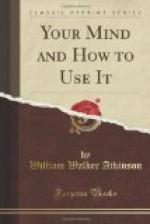EXERCISE
Exercise 1. Point out an undesirable habit that you are determined to eradicate. Describe the desirable habit which you will adopt in its place. Give the concrete steps you will take in forming the new habit. How long a time do you estimate will be required for the formation of the new habit? Mark down the date and refer back to it when you have formed the habit, to see how accurately you estimated.
CHAPTER V
ACTIVE IMAGINATION
A very large part of the mental life of a student consists in the manipulation of images. By images we mean the revivals of things that have been impressed upon the senses. Call to mind for the moment your house-number as it appears upon the door of your home. In so doing you mentally reinstate something which has been impressed upon your senses many times; and you see it almost as clearly as if it were actually before you. The mental thing thus revived is called an image.
The word image is somewhat ill-chosen; for it usually signifies something connected with the eye, and implies that the stuff of mental images is entirely visual. The true fact of the matter is, we can image practically anything that we can sense. We may have tactual images of things touched; auditory images of things heard; gustatory images of things tasted; olfactory images of things smelled. How these behave in general and how they interact in study will engage our attention in this chapter.
The most highly dramatic use of images is in connection with that mental process known as Imagination. As we study the writings of Jack London, Poe, Defoe, Bunyan, we move in a realm almost wholly imaginary. And as we take a cross-section of our minds when thus engaged, we find them filled with images. Furthermore, they are of great variety—images of colors, sounds, tastes, smells, touches, even of sensations from our own internal organs, such as the palpitations of the heart that accompany feelings of pride, indignation, remorse, exaltation. A further characteristic is that they are sharp, clean-cut, vivid.
Note in the balcony scene from Romeo and Juliet, the number, variety and vividness of the images:




